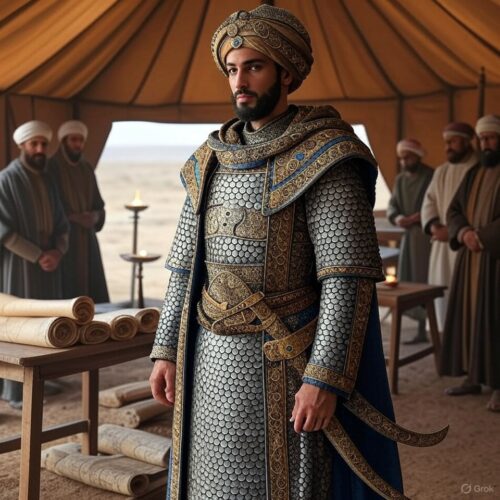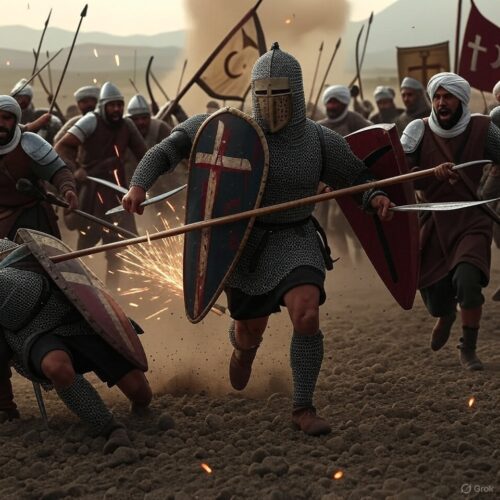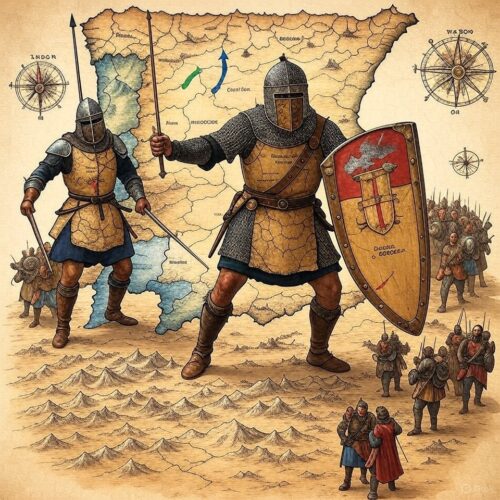Imagine a scorching summer day in the year 939 AD, where the dusty plains near the city of Simancas in northern Spain became the stage for a clash that would alter the course of a nation’s destiny. On August 6, the forces of King Ramiro II of León, bolstered by alliances and sheer determination, faced off against the formidable army of Caliph Abd al-Rahman III of Córdoba—a man whose empire spanned vast territories and whose military might seemed unbeatable. This wasn’t just a battle; it was a pivotal moment in the Reconquista, the centuries-long struggle to reclaim the Iberian Peninsula from Muslim rule. The Battle of Simancas wasn’t merely a victory for the Christians; it was a testament to how strategy, unity, and resilience can turn the tide against overwhelming odds. In this blog, we’ll dive deep into the historical intricacies of this event, exploring its context, key players, tactics, and lasting impact. Then, we’ll bridge the gap to today, showing how the lessons from this ancient confrontation can empower you to conquer your own modern battles. Get ready for a journey that’s part history lesson, part adventure story, and all inspiration.
### The Historical Tapestry: Setting the Stage for Simancas
To truly appreciate the Battle of Simancas, we must first unwind the threads of history that led to this explosive encounter. The Iberian Peninsula in the 8th century was a mosaic of cultures and conflicts. In 711 AD, Muslim forces under Tariq ibn Ziyad crossed the Strait of Gibraltar, swiftly conquering the Visigothic kingdom and establishing Al-Andalus, a thriving Islamic territory known for its advancements in science, architecture, and agriculture. Cities like Córdoba became beacons of learning, where scholars translated Greek texts and developed algebra, while the Christian kingdoms in the north clung to their footholds in the mountains of Asturias and Navarra.
By the 10th century, the Umayyad Caliphate of Córdoba had reached its zenith under Abd al-Rahman III. Born in 891 AD, Abd al-Rahman ascended to power in 912 as emir and proclaimed himself caliph in 929, asserting independence from the Abbasid Caliphate in Baghdad. His reign was marked by military prowess and administrative genius. He centralized authority, built a professional army including Slavic mercenaries (known as Saqaliba) and Berber warriors, and expanded his influence through campaigns that subdued rebellious factions within Al-Andalus. Abd al-Rahman’s court was legendary; he constructed the opulent palace-city of Madinat al-Zahra near Córdoba, a symbol of his wealth and cultural sophistication. But his ambitions extended north, where the Christian kingdoms posed a persistent threat.
In the north, the Kingdom of León emerged as a bulwark of Christian resistance. Founded in the early 10th century, León was a successor to the Kingdom of Asturias, the cradle of the Reconquista. King Ramiro II, who ruled from 931 to 951, was a warrior-monarch par excellence. He inherited a realm plagued by internal strife and external pressures but quickly consolidated power by defeating rivals like his brother Alfonso IV. Ramiro’s alliances were crucial; he forged ties with the County of Castile under Fernán González, a semi-independent noble whose cavalry would prove decisive. The Christians, though outnumbered and technologically similar to their foes (both sides used chain mail, swords, and lances), drew strength from their mountainous terrain and a fervent religious zeal, often invoking the aid of Saint James the Apostle (Santiago Matamoros, or “Moor-slayer”).
The buildup to Simancas began years earlier. In 934 AD, Abd al-Rahman III launched a major offensive, the “Campaign of Omnipotence,” aimed at crushing the northern kingdoms. He ravaged León’s territories, sacking cities and capturing slaves, but failed to deliver a knockout blow. Ramiro II, undeterred, rebuilt his forces and sought alliances. By 939, tensions boiled over when Abd al-Rahman assembled one of the largest armies in Al-Andalus history—estimates suggest up to 100,000 men, including heavy cavalry, archers, and infantry from across his empire. His goal was to subdue León once and for all, marching north with banners fluttering and drums beating a rhythm of conquest.
Ramiro II, aware of the impending doom, mustered his troops. His army was smaller, perhaps 20,000 to 30,000 strong, comprising Leonese knights, Castilian horsemen, and Galician infantry. Fernán González brought his famed caballeros villanos—free peasant warriors on horseback, known for their mobility and ferocity. The Christians positioned themselves near Simancas, a fortified town on the Pisuerga River, about 10 miles northwest of modern Valladolid. The landscape was a mix of open plains and ravines, ideal for ambushes and defensive stands.

### The Clash of Armies: Day-by-Day Drama at Simancas
The battle commenced on July 19, 939, but the decisive phases unfolded around August 6, marking the climax of a grueling confrontation. Abd al-Rahman’s massive force advanced with confidence, their ranks swelling with professional soldiers and jihad volunteers. The caliph’s strategy was straightforward: overwhelm the Christians with numbers, using archery volleys to soften defenses before cavalry charges.
Ramiro II, however, employed cunning tactics. He avoided direct engagement initially, harassing the Muslim supply lines and using the terrain to his advantage. Legends speak of divine intervention; chroniclers like Sampiro, the bishop of Astorga, described how Saint James appeared on a white horse, leading the Christians to victory—a motif that would recur in Reconquista lore.
As the armies clashed, the fighting was brutal and chaotic. Muslim sources, such as Ibn Hayyan’s chronicles, describe fierce hand-to-hand combat, with dust clouds obscuring the sun and the air filled with arrows and war cries. The Christians formed tight formations, their heavy infantry holding the line while cavalry flanked the enemy. Fernán González’s forces executed daring charges, disrupting the Muslim wings.
By August 6, the tide turned dramatically. The Muslim army, exhausted from prolonged engagement and logistical strains (supply lines stretched hundreds of miles), began to falter. A key moment came when the Christians exploited a ravine known as Alhandega (or al-Khandaq), where many Muslim soldiers were trapped and slaughtered. Abd al-Rahman III, seeing his forces crumble, fled the field, leaving behind treasures, weapons, and thousands of dead. Estimates of casualties vary, but Muslim losses were staggering—perhaps 50,000 killed or captured—while Christian deaths were fewer but still significant.
The battle’s ferocity is captured in contemporary accounts. The Chronicle of Albelda praises Ramiro’s leadership, noting how the king’s personal bravery inspired his men. Abd al-Rahman, humiliated, reportedly lost his prized copy of the Quran and a coat of mail, symbols of his defeat. He never fully recovered his military prestige, shifting focus to diplomacy and internal reforms.

### Aftermath and Ripple Effects: Reshaping Iberia and Beyond
The victory at Simancas had profound repercussions. For the Kingdom of León, it solidified Ramiro II’s rule and expanded his territories. He captured key fortresses like Osma and pushed the frontier south, initiating a period of Christian resurgence. Fernán González used the momentum to assert greater autonomy for Castile, laying the foundation for its future independence and role in the Reconquista.
For Al-Andalus, the defeat was a turning point. Abd al-Rahman III, though he remained a great ruler until his death in 961, curtailed large-scale northern campaigns. His successors faced internal divisions, leading to the caliphate’s fragmentation into taifa kingdoms by 1031. This weakening allowed Christian states to grow stronger, culminating in milestones like the Battle of Las Navas de Tolosa in 1212 and the fall of Granada in 1492.
Broader impacts rippled across Europe. The battle reinforced the idea of holy war, influencing the Crusades. It boosted papal support for Iberian Christians, with Popes like John X encouraging unity against the “infidels.” Economically, the victory opened trade routes and fostered cultural exchanges, as captured knowledge from Al-Andalus enriched northern libraries.
Historians debate the battle’s scale, but its significance is undeniable. It marked the end of Muslim dominance in Iberia and the beginning of Christian ascendancy, shaping Spain’s identity as a fusion of cultures. Without Simancas, the Reconquista might have stalled, altering the course of European history—from the Age of Exploration to the spread of Christianity.

Delving deeper, let’s explore the military innovations. Both sides used similar weaponry: curved scimitars for Muslims, straight swords for Christians. But the Christians’ use of stirrups for stable cavalry charges gave them an edge. Logistics played a role; Abd al-Rahman’s army, far from home, suffered from disease and desertions. Ramiro’s local knowledge allowed for guerrilla tactics, foreshadowing modern asymmetric warfare.
Personal stories add color. Ramiro II, a devout king, reportedly vowed to build churches if victorious, fulfilling it with monasteries like San Miguel de Escalada. Abd al-Rahman, a poet and scholar, lamented the loss in verses, humanizing the caliph as more than a conqueror.
The battle’s legacy endures in Spanish folklore. Festivals in Simancas reenact the event, with parades and mock fights. Artworks, like 19th-century paintings by Antonio Gisbert, romanticize the heroism, while archaeologists uncover artifacts—arrowheads, armor fragments—near the site.

Extending our gaze, Simancas influenced global history. The strengthened Christian kingdoms eventually sponsored Columbus’s voyages, linking the Old World to the New. Cultural synergies from the period—Arabic numerals, astrolabes—propelled the Renaissance.
### Bridging Centuries: Applying Simancas to Your Life Today
Now, let’s pivot from the past to the present. The Battle of Simancas teaches that even when faced with superior forces, victory is possible through preparation, alliances, and adaptability. In today’s fast-paced world, where challenges like career setbacks, health issues, or personal crises can feel like an invading army, these lessons are gold. The outcome—overcoming odds—can benefit you by building resilience and strategic thinking, leading to personal growth and success.
Here are specific ways to apply this historical fact to your individual life:
– **Form Strategic Alliances Like Ramiro II**: Just as Ramiro allied with Fernán González, seek mentors or partners in your endeavors. For example, if you’re starting a business, network with industry experts via LinkedIn or local meetups to gain insights and support.
– **Use Terrain to Your Advantage**: The Christians leveraged the landscape; similarly, identify your strengths and environment. If facing a tough job market, highlight unique skills like bilingualism or tech proficiency in resumes, turning potential weaknesses into assets.
– **Prepare for Prolonged Engagements**: The battle lasted weeks, requiring endurance. In fitness goals, commit to a 30-day plan with daily walks building to runs, tracking progress to maintain momentum.
– **Invoke ‘Divine’ Inspiration**: While not literal, draw motivation from higher purposes. If overcoming addiction, join a support group and visualize success as a ‘saintly’ guide, reinforcing commitment.
– **Learn from Defeats Like Abd al-Rahman**: The caliph adapted post-loss; after a failure, analyze what went wrong—say, a failed exam—and adjust study habits, turning setbacks into stepping stones.
To implement these, here’s a practical plan:
- **Assess Your Battlefield (Week 1)**: Identify a personal challenge, like debt reduction. List ‘enemy’ factors (high interest) and ‘allies’ (budget apps).
- **Build Alliances (Weeks 2-3)**: Connect with three people for advice— a financial advisor, friend, online forum. Schedule meetings.
- **Devise Tactics (Week 4)**: Create a strategy, e.g., cut expenses by 20%, track weekly.
- **Engage and Adapt (Ongoing)**: Execute the plan, review monthly, adjust as needed.
- **Celebrate Victories (Milestone)**: Upon progress, reward yourself, like a small trip, to sustain motivation.
By channeling Simancas, you’ll not only overcome obstacles but thrive, turning history into your superpower.

